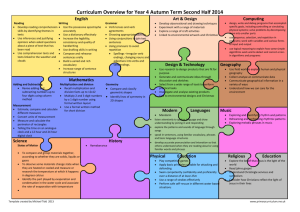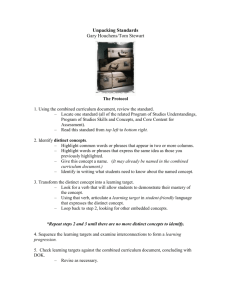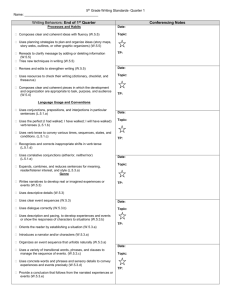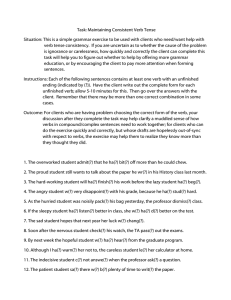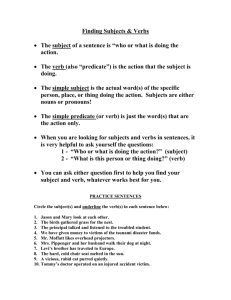Document 14013163
advertisement
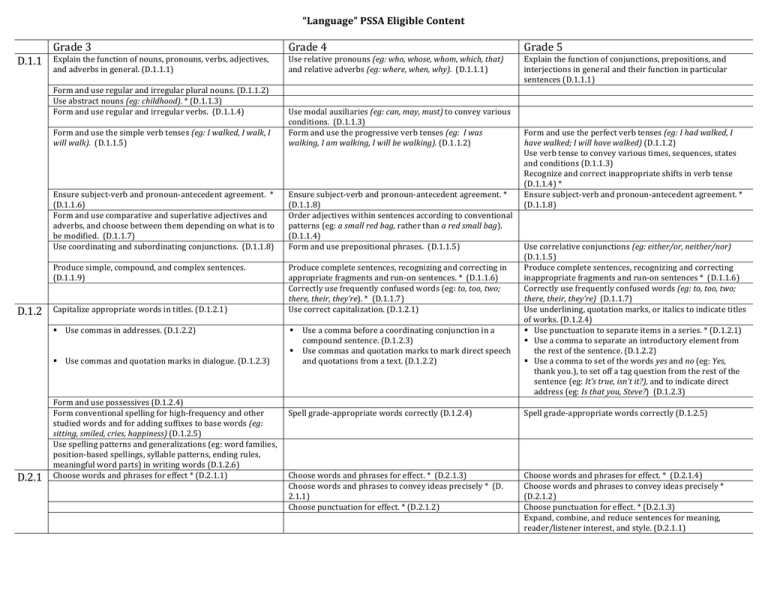
“Language” PSSA Eligible Content Grade 3 D.1.1 Explain the function of nouns, pronouns, verbs, adjectives, and adverbs in general. (D.1.1.1) Form and use regular and irregular plural nouns. (D.1.1.2) Use abstract nouns (eg: childhood). * (D.1.1.3) Form and use regular and irregular verbs. (D.1.1.4) Form and use the simple verb tenses (eg: I walked, I walk, I will walk). (D.1.1.5) D.1.2 D.2.1 Grade 5 Use relative pronouns (eg: who, whose, whom, which, that) and relative adverbs (eg: where, when, why). (D.1.1.1) Explain the function of conjunctions, prepositions, and interjections in general and their function in particular sentences (D.1.1.1) Use modal auxiliaries (eg: can, may, must) to convey various conditions. (D.1.1.3) Form and use the progressive verb tenses (eg: I was walking, I am walking, I will be walking). (D.1.1.2) Ensure subject-­‐verb and pronoun-­‐antecedent agreement. * (D.1.1.6) Form and use comparative and superlative adjectives and adverbs, and choose between them depending on what is to be modified. (D.1.1.7) Use coordinating and subordinating conjunctions. (D.1.1.8) Ensure subject-­‐verb and pronoun-­‐antecedent agreement. * (D.1.1.8) Order adjectives within sentences according to conventional patterns (eg: a small red bag, rather than a red small bag). (D.1.1.4) Form and use prepositional phrases. (D.1.1.5) Produce simple, compound, and complex sentences. (D.1.1.9) Produce complete sentences, recognizing and correcting in appropriate fragments and run-­‐on sentences. * (D.1.1.6) Correctly use frequently confused words (eg: to, too, two; there, their, they’re). * (D.1.1.7) Use correct capitalization. (D.1.2.1) Form and use the perfect verb tenses (eg: I had walked, I have walked; I will have walked) (D.1.1.2) Use verb tense to convey various times, sequences, states and conditions (D.1.1.3) Recognize and correct inappropriate shifts in verb tense (D.1.1.4) * Ensure subject-­‐verb and pronoun-­‐antecedent agreement. * (D.1.1.8) § Use commas in addresses. (D.1.2.2) § Use commas and quotation marks in dialogue. (D.1.2.3) § Form and use possessives (D.1.2.4) Form conventional spelling for high-­‐frequency and other studied words and for adding suffixes to base words (eg: sitting, smiled, cries, happiness) (D.1.2.5) Use spelling patterns and generalizations (eg: word families, position-­‐based spellings, syllable patterns, ending rules, meaningful word parts) in writing words (D.1.2.6) Choose words and phrases for effect * (D.2.1.1) Spell grade-­‐appropriate words correctly (D.1.2.4) Use correlative conjunctions (eg: either/or, neither/nor) (D.1.1.5) Produce complete sentences, recognizing and correcting inappropriate fragments and run-­‐on sentences * (D.1.1.6) Correctly use frequently confused words (eg: to, too, two; there, their, they’re) (D.1.1.7) Use underlining, quotation marks, or italics to indicate titles of works. (D.1.2.4) § Use punctuation to separate items in a series. * (D.1.2.1) § Use a comma to separate an introductory element from the rest of the sentence. (D.1.2.2) § Use a comma to set of the words yes and no (eg: Yes, thank you.), to set off a tag question from the rest of the sentence (eg: It’s true, isn’t it?), and to indicate direct address (eg: Is that you, Steve?) (D.1.2.3) Spell grade-­‐appropriate words correctly (D.1.2.5) Choose words and phrases for effect. * (D.2.1.3) Choose words and phrases to convey ideas precisely * (D. 2.1.1) Choose punctuation for effect. * (D.2.1.2) Choose words and phrases for effect. * (D.2.1.4) Choose words and phrases to convey ideas precisely * (D.2.1.2) Choose punctuation for effect. * (D.2.1.3) Expand, combine, and reduce sentences for meaning, reader/listener interest, and style. (D.2.1.1) Capitalize appropriate words in titles. (D.1.2.1) Grade 4 § Use a comma before a coordinating conjunction in a compound sentence. (D.1.2.3) Use commas and quotation marks to mark direct speech and quotations from a text. (D.1.2.2)
